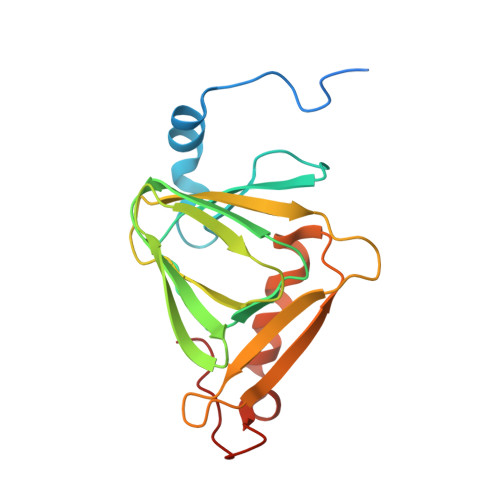Observing 3-hydroxyanthranilate-3,4-dioxygenase in action through a crystalline lens.
Wang, Y., Liu, K.F., Yang, Y., Davis, I., Liu, A.(2020) Proc Natl Acad Sci U S A 117: 19720-19730
- PubMed: 32732435
- DOI: https://doi.org/10.1073/pnas.2005327117
- Primary Citation of Related Structures:
6VI5, 6VI6, 6VI7, 6VI8, 6VI9, 6VIA, 6VIB, 6X11 - PubMed Abstract:
The synthesis of quinolinic acid from tryptophan is a critical step in the de novo biosynthesis of nicotinamide adenine dinucleotide (NAD + ) in mammals. Herein, the nonheme iron-based 3-hydroxyanthranilate-3,4-dioxygenase responsible for quinolinic acid production was studied by performing time-resolved in crystallo reactions monitored by UV-vis microspectroscopy, electron paramagnetic resonance (EPR) spectroscopy, and X-ray crystallography. Seven catalytic intermediates were kinetically and structurally resolved in the crystalline state, and each accompanies protein conformational changes at the active site. Among them, a monooxygenated, seven-membered lactone intermediate as a monodentate ligand of the iron center at 1.59-? resolution was captured, which presumably corresponds to a substrate-based radical species observed by EPR using a slurry of small-sized single crystals. Other structural snapshots determined at around 2.0-? resolution include monodentate and subsequently bidentate coordinated substrate, superoxo, alkylperoxo, and two metal-bound enol tautomers of the unstable dioxygenase product. These results reveal a detailed stepwise O-atom transfer dioxygenase mechanism along with potential isomerization activity that fine-tunes product profiling and affects the production of quinolinic acid at a junction of the metabolic pathway.
Organizational Affiliation:
Department of Chemistry, The University of Texas at San Antonio, San Antonio, TX 78249.

















